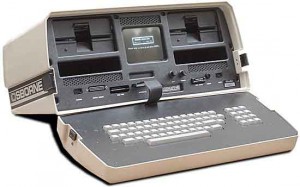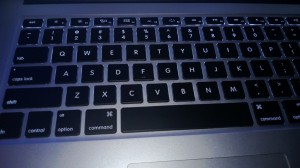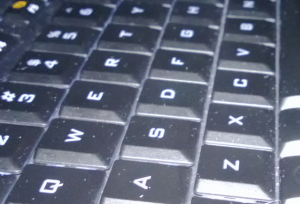Unless you plan on piercing your finger and scrawling in blood every time the muse strikes, you’re going to need some tools to get the job done. My career in information technology (IT) seems to attract a deluge of questions about personal computers, operating systems, and nifty tools. My answers, depending on what kind of party it is and how free the alcohol is flowing, will range from insightful to snarky.
In the next few articles, I’ll talk about the tools modern writers can use to help them. If you’re shopping for a new laptop, tablet, or if you’re insane enough to write a novel on your cell phone, I have some suggestions to make your life easier. I’m going to be making a lot of generalizations, so if you work in IT you’ll indulge me.
First, let’s get the booze out of the way. Writing is a fantastic excuse to have a few drinks while you’re checking Facebook. Social media aside, writers have a long history of loving their booze, from Hemingway to Hunter S. Thompson, drinking and writing seem to go together like bacon and cheese, bacon and ice cream, bacon and smoked turkey. Bacon flavored alcohol doubly so. Truth be told, recent studies show that moderate amounts of alcohol can improve your creativity. The trick is moderation, something I’m not remotely familiar with but I will try to write about anyway. Just try to control yourself, otherwise you’re likely to fall into a fit of depression and consider the Hemingway solution as a crowning achievement to the peak of your writing career.
Let’s discuss laptops. Unless you’re ancient (like, mid-40’s or something), you probably know that modern laptops have really replaced desktop computing in terms of available power and cost. But when shopping for a laptop, what should you look for? There’s so much to choose from, which ones work for writing? Which ones have good keyboards? Which ones can store your collection of Polka and Rockabilly classics? Let’s break it down into a few basic categories:
terms of available power and cost. But when shopping for a laptop, what should you look for? There’s so much to choose from, which ones work for writing? Which ones have good keyboards? Which ones can store your collection of Polka and Rockabilly classics? Let’s break it down into a few basic categories:
1. Brand: The easiest breakdown with brand relates to operating system. Either you like Macs, or you like real computers. I’m partially kidding. When shopping for a computer, it’s good to be educated about the brands out there. First and foremost, steer clear of retail. You’re going to pay too much overhead. Shop at sites like Newegg, Amazon, Buy.com, or directly from the manufacturers sites.
Apple makes great laptops. They’re sturdy, the Mac operating system is relatively easy to use, and there are some great writing tools available. Macs are stupid expensive though. And if you’re not web or techno-savvy, you may end up shorting yourself. Most journals, editors, and agents want submissions in Word. Microsoft makes Office for Mac, but it’s easy to save the wrong version and upload incompatible files unless you’re familiar with the operating system. The new Retina displays are easy on the eyes and have a resolution and backlight that reduces glare in direct sunlight. Mac keyboards are the chiclet-style with low trigger distance but are fairly comfortable to use. Bottom line, Macbooks make great laptops, but be prepared to spend nearly twice what you’d spend in an equivalent PC.
On the Windows side, there are one hojillion manufacturers of laptops. The big named brands include Dell, Sony, Toshiba, HP, and Acer. Sure, there are others, including some boutique manufacturers, but those are the biggest. On the PC side, brand really matters little. It’s the hardware that’s important.
We can’t talk about Windows PCs without mentioning Windows 8. The latest OS from Redmond is quite possibly the best, leanest, cleanest version of windows yet! it also sports an interface that’s nearly disastrous. Gone is the Start button and Start menu, replaced now with the Charms bar and Metro screen. It’s sufficient to note that it’ll take a bit of getting used to, and it’ll be much easier if you have a laptop with a touch screen. Most of the newer laptops shipping with Windows 8 have touch screens, so you’re going to be just fine in that arena. Otherwise, do yourself a favor and stick with Windows 7, or consider an application that puts the classic windows Start menu back in place, like Start8 from Stardock. It’s a testament to Windows 8’s failure to live in two worlds when you need a third-party application to make your machine functional. But if you have a touchscreen, or you’re using one of the new Windows 8 tablets, you’re going to love it.
2. Keyboard: I put this second since we’re talking about writing. Unless you’re in the market for a typewriter (and if so, you’re probably too old to be on the internet), then the keyboard is one of the most important decisions you’ll make in a writing laptop. Nearly all writing laptops are scissor-switch. Typically what that means is a short travel distance to trigger, and a responsive feedback (spring-ness). Either you like scissor-switch, or you don’t. Plenty of writers really like the old IBM style clickity-keys. The ones that make a satisfying KERCHUNK when you press them. You won’t find such a thing in a laptop, but there’s no reason you can’t spring for a USB keyboard either.
Next, consider the style of keys. Chiclet-style keyboards are the latest fashion in laptops. Usually they’re scissor-switch, and typically have some spaces
between the keys. I prefer chiclet keyboards, as standard scissor-switch keyboards where the keys meet up can snag if you’re a lazy typist or are writing particularly fast. With some standard scissor-switch boards, it’s possible to drag the edge of your finger along a separate key, tugging the key up. Over time, this can loosen or even break the key off. I haven’t seen many newer keyboards with this issue, but I had a Toshiba years ago that suffered from that problem.
Backlit keyboards are either illuminated around the keys, or from within the keys themselves. Usually manufacturers employ one or more white LED lights that generate little heat. The keys have clear plastic spacers that join the printing to the backlight assembly. This means you can type in the dark. Since most QWERTY typists don’t really look at their keyboards, this may seem like it’s of limited use, but trust me – when you’re writing in the dark and need to hit SHIFT-F7 (thesaurus in Word), or lower your volume or hit PRINTSCRN, you’ll be glad you have a backlit keyboard. It’s becoming a standard feature, so you’re likely to find them everywhere.
Bottom line – if you can find a similar laptop in retail, test out the keyboard before you buy it.
3. Type: Manufacturers like to break laptops down into distinct categories. They’ll throw out funky names like Ultrabook, Laplet, or Mobile Workstation or some other silly name. As far as I’m concerned, if it looks like a laptop, it’s a laptop. Ultrabooks are Intel’s attempt to push manufacturers to build something that resembles a Macbook. Laplets are usually tiny laptop/tablet hybrids, and I haven’t yet seen one that doesn’t suck. Smaller mobile laptops usually sport cramped keys. if you have Sasquatch hands, are prone to fat-fingering, or are a lazy typist who doesn’t completely lift fingers when traveling to the next key, you’ll want a regular sized keyboard in your laptop. What’s considered Full Size usually means the number pad is next to the keys. Unless you’re an accountant, that’s probably not going to be much use to you.
4. Processor: There are two major (well… as of this writing) processor manufacturers – Intel and AMD. Intel produces the fastest, most power efficient processors. AMD chips are usually less expensive, but you get what you pay for. I have trouble recommending AMD, especially since the company is on the verge of bankruptcy.
On the Intel side, nearly all Intel chips are multi-core. That translates to multiple processors on a single physical chip. Each core can handle separate instructions, and some programs can take advantage of that. Think about it like check-out lines in the grocery store. One line is slow, but everybody gets served. Two lines are better because the clerks can check people out simultaneously. Having some extra lines for limited item customers is even better. Plus you can have bacon only lines which… I’m getting off track. Multi-core processors let you write while you’re downloading the latest episode of Mad Men in the background, or write and listen to iTunes at the same time without making your processor beg for a break.
Actual processing speeds mean little anymore. Intel produces processors in different “classes”. The Core i3 series are budget targeted, and usually have less cores and less power. Core i5 is usually the best price/performance and will last you a few generations. Core i7 is typically enthusiast aimed – for the folks that do lots of things simultaneously and need the fastest processor available.
5. Video Cards: You’re not buying a laptop capable of playing Call of Duty: Kill All Humans Edition, so the video card shouldn’t factor too much in your buying decision. It’s worth noting that discreet cards are far better than shared memory cards. The Intel video chips use shared memory, and render images as quickly as a constipated ninety-year-old. You’ll end up thinking your laptop is slow and crappy when it’s probably just your underpowered video card. While Word and other programs don’t exactly push the pixels, the video card comes into play when you’re browsing the net and looking at those lovely full-page ads for Bacon Memorabilia. We’re shifting into an era where the video card has become one of the processor cores, which makes this less of an issue. If you can, get a system that has a discrete video card. This is more important when you’re buying a second-hand laptop.
5. Memory: Computers are stupid, kind of like idiotic puppies who can’t follow instructions past some basic “Sit, Stay, Beg” commands. Computers need memory to store programs and help remember what it is they’re doing. The more RAM you have the better, up to a point. I recommend a minimum of 4 gigabytes (4GB) of memory for any modern computer. 8 gigabytes is preferred (8GB). Anything more than 8 is great, but overkill. If your running Windows Vista or Windows XP, or you have a 32-bit version of Windows, you should know that Windows cannot address beyond 2 gigabytes of memory. Windows 7 has some tricks around it, but it slows everything down. Bottom line, stick with Windows 7 64-bit and aim for 4-8 gigs of ram.
6. Disk Drive: Despite what you’ve heard, the “disk drive” is not your entire computer. Rather, it’s the way your computer remembers stuff when the power is switched off. It’s like a giant file cabinet. Today, there are two major kinds of disk drives: Solid State and Mechanical (and hybrid, but we’ll go into that later).
Solid State drives are like really big USB memory sticks. They’re extremely fast, and can greatly improve the performance of any computer. They’re also very expensive. You’ll usually pay twice as much for a Solid State drive that’s half as big as a mechanical counterpart. That being said, I think it’s worth it. Having your computer ultra-responsive is great, and writing doesn’t take up a lot of room so you’re not likely to fill it up. if you’re shopping for a solid-state drive or a solid-state laptop, I’d recommend no less than 64 gigabytes. 120 gigabytes seems to be the best price/storage space break point (at least for now), but SSD prices are falling faster than Lindsay Lohan’s career. The more storage you can get, the better.
Mechanical drives are made of thin magnetic platters. They look kind of like record players on the inside. There’s a mechanical arm that moves over the disk, and there are usually multiple platters where the information is stored. Being mechanical, these drives are slower. They’re usually rated in spin-speed. 5200 RPM is the standard. 7200 RPM is better, and offers improved performance but needs more power. 10,000 RPM drives are rare, and typically reserved for server products. You’re likely to find a laptop with a 5200 RPM drive that has twice as much storage space as a laptop with a SSD.
Hybrid drives are a variation of the two, the result of a mad drunken night between a mechanical drive and a solid-state drive. Hybrid drives usually have a chunk of solid-state storage with one or more platters. The logic engine in the drive sticks commonly used data on the solid-state portion. The user doesn’t have to do anything, and sees the entire disk as one drive. It used to make sense to have hybrid drives, but SSD prices have gotten so low that it’s better to go with an SSD option if you can.
7. Resolution: If you plan on writing with a laptop, it’s best to have a decent display that doesn’t hurt your eyes, has an adjustable backlight, and low glare. Plus, better resolution means your cats-who-look-like-hitler pictures will look better! Resolution is broken down to two sets of numbers – horizontal pixel count by vertical pixel count (or Width by Height). HDTV resolution is broken into two basic categories – 720p (1280×720) and 1080p (1920×1080). The “p” stands for Progressive Scan – every horizontal line will be drawn for every single frame. That gives you a smoother picture. 720i and 1080i also exist – the “i” stands for Interlaced – every other line is drawn every frame, giving a less clear image – but you won’t find interlaced in a laptop. Most laptops are 1680×1050 for a 15″ screen.
You’ll also need to consider screen size. A 1080p resolution is great, but on a 13″ laptop screen, will you really notice? 15″ screens are about as small as I can handle without straining my eyes. 17″ screens are better, but there’s a tradeoff between screen size and laptop weight. You can have a great resolution 17″ or 18″ laptop that’s easy on the eyes, but kills your shoulder because it weighs 10 pounds. With increased screen size comes more power requirements and reduced battery life.
The Bottom line: As a writer, you want a laptop that’s lightweight, powerful, has a decent screen and a comfortable keyboard. An Intel Core i5 processor with at least 4 gigabytes of RAM is a good start. A 15″ 1680×1050 screen (or better) will help your eyes adjust. A bright low-glare screen means you may be able to write outside in sunlight. Solid-State drives have less room to store your data, but are far faster making your laptop seem like it loads your latest story before you’re done clicking the file. Keyboards vary by preference, so find a style you’re comfortable with.
Here are some recommended examples – laptops I’ve either reviewed for a tech site, used at some point, or own:
Macbook Pro: Macs are expensive, borderline arrogantly elitist machines. Despite what the Mac fanatics want you to believe, the Mac operating system isn’t free of viruses. Caveats aside, the Macbook Pro Retina 15″ is a fantastic machine. All solid state (save some cooling fans), great keyboard, decent battery life, and good all around performance. The retina display is easy on the eyes and is one of the few displays visible in sunlight. But you’re going to pay for it. Expect to shell out anywhere from $1900-$2500 depending on your options. Available directly from Apple, Apple Retail stores, Best Buy and a few other brick-and-mortar outlets.
Dell Inspiron: The Inspiron series has a long and sordid history. The latest, the “z” series, has some decent examples. The newest 15z is a decent laptop for the money. As a writer, you won’t need anything better than the base model, unless you plan on editing video or playing the latest games in the best resolution… but if that’s the case then you aren’t writing, so why are you here? The base model 15z will run you around $700, available directly from Dell.
Toshiba Satellite U845: Toshiba doesn’t always make the best laptops, but the Satellite U845 manages to hit all the right notes. An Intel Ultrabook, the U845 is lightweight, chiclet-keyboard system with a 5400 RPM drive and decent processing power. Expect to pay around $800 for the base model, available from Newegg, Amazon, Best Buy, and a few other brick and mortar outlets.
Acer Aspire V5-571: Acer isn’t exactly a household name in the world of mobile computing, but they make some decent equipment. The Aspire V5-571 is one of the best ultrabooks on the market at a great price point – starting around $650. The keyboard is a bit closed in, but still functional. Definitely a worthy low-end option for the mobile writer.
And that sums up the laptop portion. Next up I’ll be looking at Tablet computing and writing software.


